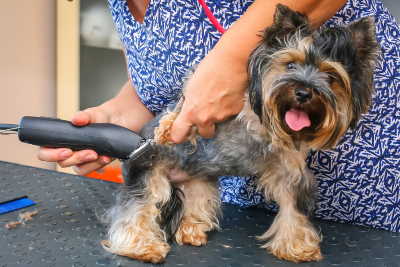How to Introduce Your Dog to Your Baby for the First Time
Introduce Your Dog to Your Baby By Molly Crockett |Published 03-27-2020
Dogs make great companions for children; for many of us who grew up around dogs, our fondest memories are with them. Long walks through parks and woods, playing catch in the garden, snuggling up with our pooches at night – and always, always, having a companion who loves you more than anything in the world!
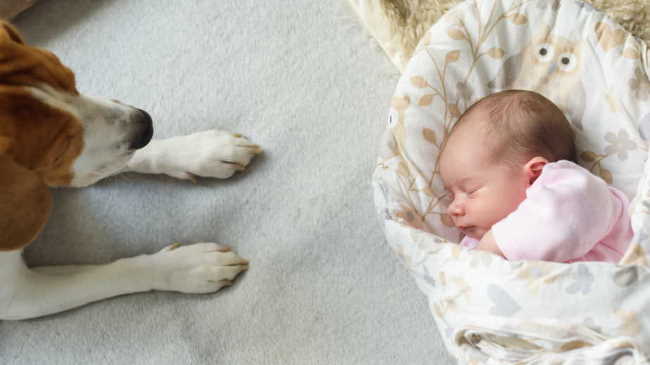 It takes time before parents feel they can trust their baby around a dog. Keep that in mind when you introduce your dog to your baby.
It takes time before parents feel they can trust their baby around a dog. Keep that in mind when you introduce your dog to your baby.However, it often takes some time before parents trust a dog with their baby, and it may take some time for the dog to get used to the new arrival.
That’s why the first meeting between your newborn and your dog is so important – this will set the tone for the rest of the relationship, so make sure you get it right!
Can Dogs Read Our Emotions?
Dogs are generally very in tune with their human owners, particularly our emotions. They can sense the new parents’ excitement, apprehension, and more negative emotions like fear and anxiety. With an event as monumental as a pregnancy, they can sense that things are changing – but they might not know what is happening!
So, how you choose to handle introducing your baby to your dog is very important – and be careful to check in with yourself about your feelings, too. If you are afraid of your dog’s reaction, they will sense this fear and feel frightened, also. If you are positive and introduce the baby joyfully, chances are your dog will feel good about it, too.
A New Experience for Your Dog: A Baby!
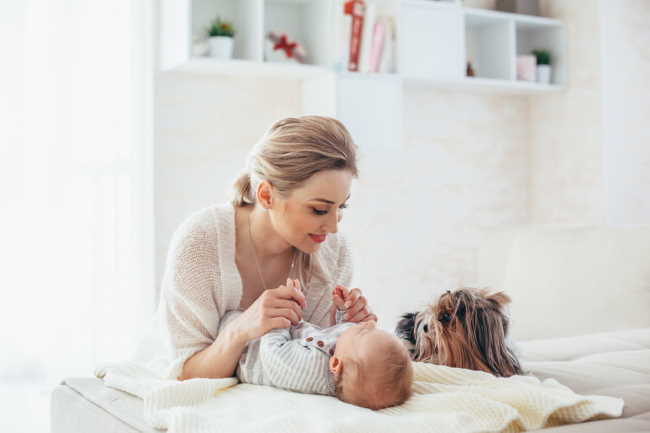 When you Introduce Your Dog to Your Baby remember it's a new experience for all.
When you Introduce Your Dog to Your Baby remember it's a new experience for all.A baby can be a lot for a dog to get to grips with – they are, after all, tiny humans that smell, sound, and move entirely differently to big humans!
Your dog might never have seen a baby before, and all of a sudden, this tiny, loud human is taking up all of their owner’s time. Your dog might be confused, and they might even be jealous of the new arrival.
But if you plan and take the right steps before your baby arrives, you can create a bond between the new member of the family and their four-legged sibling!
Here are the best ways to prepare yourself and your dog for the new arrival!
15 Tips to Help You Introduce Your Dog to Your Baby
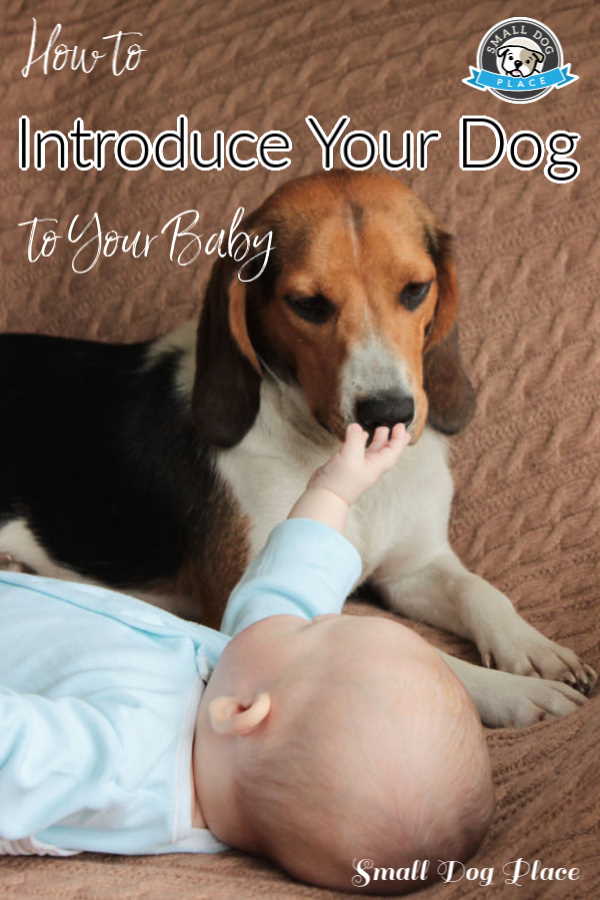 How to Introduce Your Dog to Your Baby: Pin for Future Reference
How to Introduce Your Dog to Your Baby: Pin for Future Reference1. Make sure your dog is well trained
This means taking basic obedience classes or hiring a dog trainer to work with you and your dog. Being able to command your dog not to jump, to sit down, and stay are all basic things that your dog needs to be able to do before you introduce them to your baby. You should also work on training your dog to come to you when you call – these will all come in handy in other situations, not just with a baby!
“The point here is to focus on leadership: you have nine months to work with your dog to train them and eliminate their worst habits. You must establish yourself as pack leader now so that your dog continues to obey you when you have a screaming baby in your hands!” Says Judith Garner, a lifestyle blogger at Bigassignments and Studydemic.
2. Make gradual changes to your dog’s routine
If anything is for sure, a baby will wreak havoc on the routine of the whole household. Get your dog ready for the possible changes beforehand – for example, if your dog will be walked later because you have to feed your baby in the morning, or sleep in later because they’ve kept you up all night crying!
Try to anticipate changes in your dog’s routine and start the new routine before the baby arrives, so the dog will not associate any changes with the baby. This will stop your dog from blaming the baby if they are fed or walked later than usual!
3. Start walking your dog with a stroller
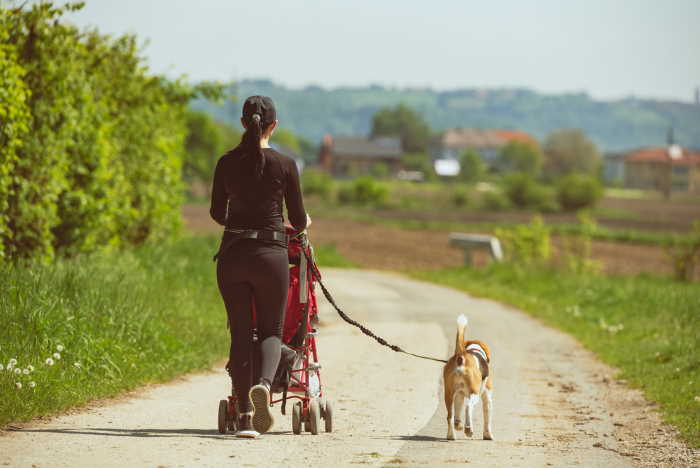 It will be easier to introduce your dog to your baby if you already feel comfortable pushing a stroller and walking a dog.
It will be easier to introduce your dog to your baby if you already feel comfortable pushing a stroller and walking a dog.The fewer changes that happen all at once, the better – that includes changes to your dog’s walking habits. Walking with a stroller might mean taking a different route or going slower than usual. You can prepare your dog for this by walking them with a stroller well before the baby arrives.
4. Gradually lessen the amount of time you spend playing with your dog
The worst thing to do before a baby arrives is lavish your dog with attention last-minute, only to stop it when your baby comes. You should aim to gradually decrease the amount of attention you give to your dog and the amount of time you spend playing with them around 2-3 weeks before the expected birth date.
5. Play a tape recording of baby sounds
This is particularly useful to get your dog used to the sound of crying – which they are going to be hearing a lot of shortly! At first, try playing baby sounds for a short period, and gradually increase the length of time you play the sounds for so your dog can adjust.
Don't know where to find a baby crying? Try this YouTube video:
Introduce Your Dog to Your Baby: Crying Baby Sounds

6. Get your dog accustomed to the smell of a baby
Obviously, without a baby, there is no baby smell, but you can acclimate your dog to the scent of baby products like lotion and powder. If you have your baby in the hospital, you could bring a blanket home and let your dog smell it before the two meets!
7. Establish Boundaries at the nursery door
Well, before the baby comes home, you have to teach your dog that the nursery is off-limits, and there is an invisible barrier there that your dog must not cross without permission.
You might allow your dog to explore and sniff around, under your supervision, but you control all of this and decide when they enter and leave. This lets your dog know this is your room and must always be respected.
You may need to install a physical barrier if training is unsuccessful.
8. Teach your dog, the command: ‘go-to place.’
“This is a useful trick that will come in handy if you ever need your dog to leave your baby alone,” says Arran Valentine, a pet writer at Oxessays and Eliteassignmenthelp.
“Use any mat, bed, or defined area, and train your dog to go there. You can do this by using treats, pointing to the area, and saying clearly ‘place’ and rewarding your dog when they go there on command.
Once they have learned the ‘place,’ add the command sit or down. Give your dog a reward once they are there, like a chew toy. They should learn that when commanded, they have to go there and sit and wait for a treat!”
9. Take the following steps when introducing your dog and your baby
Firstly, greet your dog alone, not whilst holding your baby – you don’t want your dog to jump up and all over your baby and scare them!
Give your dog a couple of days to adjust to the smell, sight, and sound of the baby before bringing them together in closer proximity.
Once a few days have passed, allow your dog to sniff your baby whilst they are on a leash. Give your dog plenty of encouraging pets and kind words in this first meeting. You might want to take them a walk first, to tire them out, or at least ensure your dog is in a calm, submissive state beforehand by practicing some commands and giving them some treats.
Remember, don’t be anxious – your dog senses your feelings and will mirror them.
Allow your dog to approach the baby and choose to interact with them – forcing your dog to go closer is not advised. Let it be their choice to interact with the new-born!
Once you feel your dog is used to the baby, allow them to sniff the baby off the leash, and to be free to move away if they want to.
Dogs may react differently when the baby screams, cries, or kicks. Always keep an adult present, just in case!
10. Continue giving your dog a lot of attention
Praise your dog a lot when the baby is around, and don’t let them associate the baby with not receiving your love! Most dogs are fine with babies taking up a bit more of their owner’s time, but it’s better to err on the side of caution! That equates to not letting your dog feel neglected when the baby is around.
11. Don’t scold your dog for picking up the baby’s things
This may lead the dog to associate the smell of the baby with adverse reactions from their owner. So, don’t scold dogs for playing with the baby’s toys or picking up their blankets or food – simply take them away gently.
12. Teach your baby to respect your dog
Babies grow quickly, and it can be difficult for dogs to adapt. Once they start crawling and exploring, they might start pulling on dogs’ ears and tails – this can, in some dogs, make them growl and snap back at the baby.
These are natural behaviours and show that your dog is warning the baby to stop. Even the most tolerant of dogs have their limits – so always keep an eye on your baby and make sure they’re not testing these limits!
13. Don’t leave dogs alone with your baby
Even if your dog and baby are by now best friends, it’s better not to leave them alone. Accidents can always happen, and as noted, even the most trustworthy dogs have their limits, can get hurt or afraid, and lash out. Don’t risk the safety of your baby, or your fur baby!
14. Have ‘safety zones’ for your dog
Having a safe space where your dog can retreat when the baby noise or interaction is getting too much is essential. Consider a crate, a dog bed, a special room, or an area outside when your pooch needs to escape.
15. Don’t forget about your dog!
Last but not least, keep your dog’s routine going, keep walking them, keep playing with them, and don’t neglect them. Your dog needs to feel secure in at home with you as the leader. Only then will he feel relaxed around the newest addition to the family.
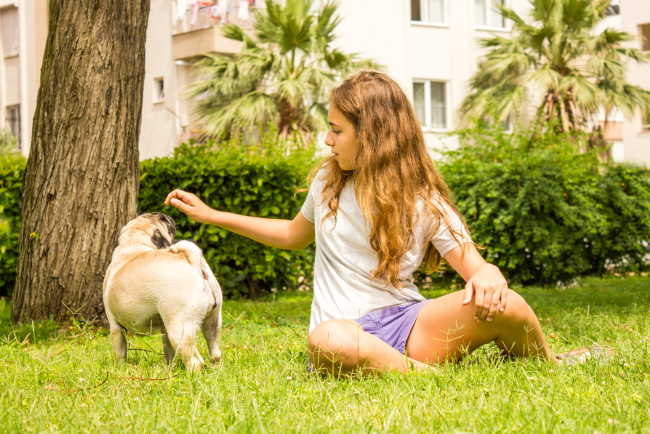 Follow these steps when you introduce your dog to your baby and you will create a strong friendship and bond between child and dog.
Follow these steps when you introduce your dog to your baby and you will create a strong friendship and bond between child and dog.Author Bio: Introduce Your Dog to Your Baby
Molly Crockett writes for Australianhelp and Paperfellows, as well as contributes to online sites, such as Stateofwriting online writing service. As a travel blogger, she enjoys sharing her experiences and her latest personal development ideas.
Introduce Your Dog to Your Baby:
Your Personal Stories
If you are like many, being a puppy mom came before being the mom to a baby of your own. Your dog thinks he/she is your baby and quite frankly, you've considered them more of a baby than a dog. Now you're faced with a new introduction.
Are you in the process of wondering how you will introduce your dog to your baby? Or, perhaps you've already mastered that hurdle. Wherever you are, we'd love to hear how you managed to bring puppy and baby together. Was it easy? Hard? Nerve wracking? Please share.
Don't forget, you're free to send a few photos of your baby and dog.
About Janice (author and voice behind this site)
Having lived with dogs and cats most of her life, Janice served as a veterinary technician for ten years in Maryland and twelve years as a Shih Tzu dog breeder in Ohio.
Her education includes undergraduate degrees in Psychology with a minor in biology, Early Childhood Education, and Nursing, and a master's in Mental Health Counseling.
She is a lifelong learner, a dog lover, and passionate about the welfare of animals. Her favorite breed for over 50 years has been the Shih Tzu, but she has also lived with Poodles, Maltese, Yorkshire Terriers, Beagles, English Bulldogs, Carin Terriers, and a Cocker Spaniel.
When not writing, reading, and researching dog-related topics, she likes to spend time with her eight Shih Tzu dogs, husband, and family, as well as knitting and crocheting. She is also the voice behind Miracle Shih Tzu and Smart-Knit-Crocheting
Does This Article Deserve Your Thumbs Up?
We always appreciate your support and encouragement. Your thumbs up means so much to us. Please like this article.
If you find this page or any page on Small Dog Place Helpful, or useful in anyway, I'd love it if you would click the small heart found on the bottom right of each page.
You can also share or bookmark this page -- just click on the:

Free Monthly Newsletter
Sign Up for Our Free Newsletter and get our Free Gift to You.
my E-book, The Top 10 Mistakes People Make When Choosing a Dog (and how to avoid them)
